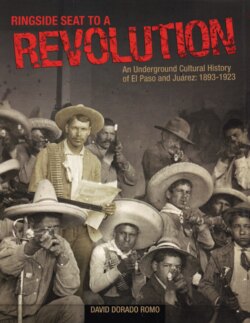Читать книгу Ringside Seat to a Revolution - David Dorado Romo - Страница 24
На сайте Литреса книга снята с продажи.
Оглавление19
Mexican men of that era when they came from the pen
of a woman.6 The anarchist Práxedis Guerrero—who
coined the phrase that is often attributed to Emiliano
Zapata, “It is better to die on your feet, than to live on
your knees,”—published Punto Rojo out of El Paso in
1909. Silvestre Terrazas, the black sheep of the
Chihuahuan oligarchic family who at one time helped
smuggle weapons for Pancho Villa from El Paso, pub-
lished La Patria between 1919 and 1925. It was one of
the more successful Spanish language papers in the
border city. Silvestre Terrazas had been sued 150 times,
imprisoned 12 and had received a death sentence under
the government of Porfirio Díaz for his writings.7 In
México, Díaz imprisoned Ricardo Flores Magón various
times as well. Each time Magón and his fellow radicals
got out of Mexican prison, they would stubbornly
republish their old newspaper under a different name—first as El Ahuizote, then El Hijo
del Ahuizote (The Ahuizote’s Son), El Nieto del Ahuizote (The Ahuizote’s Grandson), El
Bisnieto del Ahuizote (The Ahuizote’s Great-Grandson) and El Tataranieto del Ahuizote
(The Ahuizote’s Great-Great Grandson.)
Things were somewhat better for journalists in El Paso. But that’s not to say that the
U.S. was a paradise for free speech either, as Leon Metz would have us believe. Spanish-
language editors were frequently harassed, censored and imprisoned by the American
authorities for what they wrote. Flores Magón was sued and arrested several times in the
U.S. for his articles. Ultimately, censorship ended up being more severe for him north of
the border than south of it. He died in an American prison in the 1920s while serving a
20-year sentence for questioning, in one of his publications, the needless loss of life of
American soldiers during World War I.8
Spanish-language newspapers were suppressed on numerous occasions in El Paso
during the revolution. In March 1916, Mayor Tom Lea, Sr. ordered the suspension of four
“Mexican dailies” published in the city: El Rio Bravo, La Justicia, Mexico Nuevo and El Paso
del Norte.9 Their crime was to report on and give their own version of Pancho Villa’s raid
of Columbus a few days before. The editor of El Paso del Norte, Fernando Gamiochipi, a
resident of the American border city for 14 years, was thrown in jail for having written
“something of a political nature.”10
That same month, the El Paso City Council passed an emergency ordinance which stated:
It shall be unlawful for any persons within the city of El Paso to transmit for the
purpose of publication any report about the conditions existing in the city of El
Mexican American beauty
queen crowned by El Paso
Spanish-language newspaper,
El Continental, ca. 1930.
(Cleofas Calleros Papers
[MS231], Special Collections
Department, UT El Paso.)
6
The contributing writers included Isidra T. de Cardenas and the sisters of Partido Liberal Mexicano leader Antonio
Villarea, Teresa and Andrea Villareal. Historian Ward S. Albro, however, believes that Aguirre himself did most of
the writing for the publication behind the scenes. See To Die on Your Feet, pg. 82.
7
El Paso Herald-Post, June 9, 1944. After his death sentence he served incommunicado a three-month imprisonment
in Mexico City and was then pardoned by Díaz.
8
The offending sentence was this: “the boy…will be but by force torn from his family to face, gun in hand, another
youngster who like himself was the enchantment of his home, and whom he does not hate, and cannot hate, for
he does not even know him.” Ward Albro, Always A Rebel: Ricardo Flores Magón and the Mexican Revolution,
p. 145.
9
El Paso Herald, March 11, 1916.
10
El Paso Herald, March 15, 1916.
